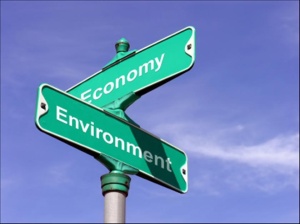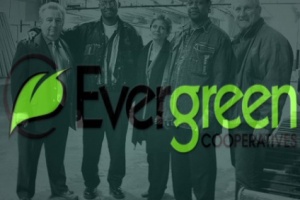There has been more and more attention focussed on this idea of the New Economy lately, and rightly so. Things in our economic system are not going so well for the majority of folks who rely on it for their livelihoods. We love to think that we are all lone rangers of the west here in the US, but the truth is that we are all necessarily linked to the economic system both in our country and now globally with the effective foothold of globalization, or the New Imperialism, firmly established. The interesting thing, however, is that things have not been going really well for the majority of folks since the begginning of our time here on this continent. There have been times of better and worse, but not good, healthy and equitable times. So, this idea that perhaps we should finally get radical (to the roots) about creating a New Economy is very refreshing!
So what is the idea of the New Economy all about and how do we get there concretely? First I will talk about the idea, then the possible set of tools or strategies to get there. A recent article in Yes! magazine by David Korten called, “What would a down-to-earth economy look like?,” sums it up nicely. Korten is basically arguing that we should (perhaps now we must) organize our economy more like nature organizes ecosystems. He states, “An economy is nothing more than a system for allocating resources to productive activity—presumably in support of life. In fact, nature is an economy, with material and information exchange, saving, investment, production, and consumption—all functions we associate with economic activity.” And…nature organizes itself in a way that sustains all life and in many circumstances allows it to flourish. Our economic system is supposed to be about sustaining life, but instead has the majority enslaved to the minority as wealth generating machines, all the while poisoning those it is supposed to support and destroying the very ecosystem we all rely on to function at all.
Korten lays out a matrix to help differentiate the charicteristics of nature vs. the Wall Street economy which I find very helpful:
Wall Street vs. Nature:
Defining value: Money vs. Life
Primary performance indicators: Growth, financial returns, flows, and assets vs. Life’s abundance, health, resilience, and creative potential
Primary dynamic: Competition to maximize self-interest vs. Cooperation to optimize self- and community interest
Decision-making power: Global, top-down, centralized, and concentrated vs. Local, bottom-up, and distributed
Time frame: Immediate return vs. Sustained yield
Local character: Uniform vs. Diverse
Resource control: Monopolized vs. Shared
Resource flows: Global, linear, one-time use from mine to dump vs. Local, circular, perpetual use, zero waste
Deficits of concern: Financial vs. Social and environmental
Measure of efficiency: Returns to financial capital vs. Returns to social and natural capital
Growth: Infinite growth of money and material consumption vs. A stage in life’s endless regenerative cycles of birth, growth, death, and rebirth
We talk alot about using bio-mimicry in manufacturing and process design for more sustainable business, but we do not talk much about bio-mimicry in terms of how to structure the very economic system within which all business operates.
Now, how do we go about doing any of this? I am going to highlight several strategies of the New Economy which are being called Community Wealth Building strategies. The Evergreen Toolkit provides some great literature about both community wealth building and the model of the Evergreen Cooperatives in Cleveland Ohio. The toolkit was authored by the Democracy Collaborative, also in Cleveland Ohio. I want to highlight four of the key community wealth building strategies and then talk to the strength not of any one strategy, but of all four of them when taken together. I would argue that re-developing the economy in each locality, by each locality, along the lines of the following community wealth building strategies, is a powerful and effective way to move towards the New Economy and the “down-to-earth economy Korten layed out.
The first strategy is called Anchor Institutions. It is a term for key institutions in a community. Anchor institutions not only include universities and hospitals, but a broader range of place-based institutions, including cultural and arts centers such as museums, libraries, community foundations and other locally-focused philanthropies, faith-based institutions (such as churches, mosques, and synagogues) and community colleges. In many places, these anchor institutions have surpassed traditional manufacturing corporations to become their region’s leading employers, and leading spenders in terms of procurement. This community wealth building strategy is really about building new businesses and infrastructure around the needs of the core anchor institutions in your community. This is important both because the anchor institutions are large, unlikely to pick up and leave, and generally already have a social mission. These institutions currently procure and do business with the business as usual mega corporations which generally do not reside in the same community, do not pay living wages, do not have a social mission, and do not truly build community wealth, but instead extract wealth from local communities and efficiently funnel it up to the few.
The second strategy is about Social Enterprises. Social enterprise refers to non-profitsthat operate businesses both to raise revenue and to further the social missions of their organizations. These businesses build locally controlled wealth, which helps stabilize community economies, and represents a shift in non-profit operation toward a model of collaborating with ‘client’ populations in community-building efforts. As of 2005, social enterprise businesses in the Social Enterprise Alliance trade association generated $525 million in business-revenue, helping support $1.6 billion worth of mission-related work. These enterprises are on the cutting edge of social entrepreneurship and the creation of new and hybrid structures which will make up the New Economy.
The third strategy is about Worker-Owned cooperatives. A cooperative is any business that is governed on the principle of one member, one vote. The first modern cooperative was a retail co-op founded by 28 people in Rochdale, England in 1844. Originally selling butter, sugar, flour, oatmeal, and tallow candles, business expanded rapidly in scope and scale as the co-op succeeded in elevating food standards — rejecting then- common tactics such as watering down milk. Co-ops today exist in many sectors of the American economy, including banking (credit unions), agriculture, electricity, housing, and grocery stores. All told, over 130 million Americans are members of at least one cooperative or credit union. Credit unions alone have assets exceeding $600 billion. Non-financial cooperatives are also growing. Retail food cooperatives, if grouped together, would constitute the fourth largest chain in the natural- foods industry. Worker-Owned cooperatives are businesses like those above, but they further differ in that they have no employees. Every person that labors to create value for the business, is also an owner of the surplus created by that labor and has substantial powers of governance. The Evergreen Cooperatives are a great example of this type of business.
The fourth strategy is about Community Development Financial Institutions or CDFI’s. First formed to combat red-lining in the 1970s (a practice whereby banks would refuse to make loans to minority neighborhoods and would literally draw a red line circling the proscribed area on a map), CDFI’s have grown to include a variety of community-focused banks, credit unions, micro-enterprise funds, loan funds, and venture capital funds that have assets of $20 billion, which they use to provide loans and technical assistance to meet the credit and finance needs of low-income individuals, community development corporations, and other community entities. CDFI’s are banks run as social enterprises, and have been playing an important role in financing the New Economy.
So, how does this all fit together into an effective and exciting New Economy strategy to build community wealth and mimic natural systems? Korten says, “We would favor local, cooperative ownership and control. Organizing from the bottom up in support of bioregional self-reliance, our economic institutions would support local decision-making in response to local needs and opportunities. Cultural and biological diversity and sharing within and between local communities would support local and global resilience and facilitate life-serving system innovation.” By harnessing the green and entreprenurial benefits of social enterprises, organized structurally as Worker-Owned Cooperatives to democratize decision making and the creation of wealth, the functional units of the economy, businesses, take on a more local, resilient and equitable nature. Then, as with Evergreen, if you center new worker-owned cooperatives around a CDFI like financial institution, the enterprises can be creatively and more democratically funded, and you can “entrap capital” produced and stored by these businesses for future use in funding new cooperatives. This capital becomes community capital controlled by the very enterprises that created it and store it (by storing I simply mean when you have capital in a short or long term account in a bank) for the community to use in democratic and sustainable development. The Anchor Institution peice comes in at the very heart and begginning of this strategy as initial worker-owned cooperatives can be created to better provide the materials, supplies and services which the anchor institutions are currently sourcing from extractive corporations outside of their community.
This was a whirlwind tour of what the New Economy can look like both theoretically and on the ground. More to follow in due time.


